The Raspberry Pi 5 is advertised as a single board computer with a CPU clocked up to 2.4 GHz, but some of the boards can run stably at a higher frequency, and Jeff Geerling found out one of his boards could be overclocked up to 3.14 GHz with no issues when running a stress test.
The Raspberry Pi 5 already delivers a two to three-times jump in performance against the previous generation Raspberry Pi 4 SBC when clocked at 2.4 GHz, but some already overclocked their up to 3.0 GHz, and many thought it was the maximum limit. But a recent firmware release proved them wrong, as it turns out some Raspberry Pi 5 boards can boot at 3.2 GHz and run stably at 3.14 GHz with an adequate cooling solution. The voltage was also adjusted in the config.txt to more or less safe settings.
Contrary to the photo above, Jeff did not use the active cooler for testing but fitted his 3 GHz capable Raspberry Pi 5 board with an Argon THRML 60-RC cooler (available on Amazon and Aliexpress) instead. After updating the firmware, he tried 2.4 GHz and 3.0 GHz for testing and both frequencies worked fine. He then switched to 3.10 GHz, and the board could still boot and run a stress test (stress-ng). Going up to 3.2 GHz looked fine at first, so he switched to 3.3 GHz, but that was a bit too much, and the Raspberry Pi 5 could not complete the boot sequence. After further (off-camera) testing, 3.2 GHz was not as stable as expected, but the Raspberry Pi could run stress-ng fine at 3.14 GHz.
Alasdair Allan acknowledged Jeff’s achievement on Twitter/X, but also referred to the firmware as “very not at all recommended” since it could potentially damage the board. Even if it does not damage your board, overclocking may not always be successful as it will depend on the specific chip used on your Raspberry Pi 5 due to small variations during manufacturing. Some boards won’t even support 3.0 GHz, while others may be able to outperform Jeff’s 3.14 GHz Raspberry Pi 5, and potentially beat his Geekbench 6.2 single-core score (967) currently the world’s record for a Pi 5.
Via Hackster.io

Jean-Luc started CNX Software in 2010 as a part-time endeavor, before quitting his job as a software engineering manager, and starting to write daily news, and reviews full time later in 2011.
Support CNX Software! Donate via cryptocurrencies, become a Patron on Patreon, or purchase goods on Amazon or Aliexpress






